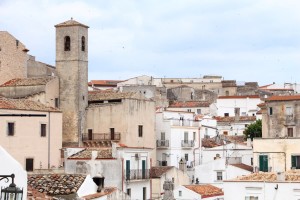Calling the fall of the Western Roman Empire a time of great changes and upheavals might just be the teensiest bit of an understatement. Numerous peoples tried their luck over subsequent decades and centuries, the ancient Migration Period was in full swing. The Lombards came to Italy in 568 AD and would rule most of the country for the following 200 years. Over those two centuries the Elbe Germanic tribe erected fascinating places of power, seven of which were collectively declared UNESCO World Heritage Site in 2011. And they’re spread across five different regions as well! Time for a tour from north to south.
How the Lombards influenced medieval times

©Bigstock.com/Tupungato
According to the UNESCO, Lombard architecture played a major role at the threshold between the ancient world and the Middle Ages. The synthesis of various architectural styles, combined with the development of a culture of their own, united Ancient Rome with Christian spirituality, Byzantine art with the Germanic Northern Europe. The origin of the name “Lombards”, however, has been lost to history.
They ruled over most of the country as Kings of Italy. Only Rome, Sardinia, Sicily and a few smaller parts in the southernmost and north-easternmost parts firmly remained under Byzantine control. While the Lombards might’ve never conquered the former centre of Western Roman power, they most definitely left their mark on the rest of Italy. Charlemagne eventually managed to dethrone the last Lombard King in 774, the last remaining traces disappeared from the regency name about 100 years later.
Gastaldaga and episcopal complex in Cividale del Friuli
Time to focus on the seven places of power of the namesake UNESCO World Heritage Site now. Our first stop is in Friuli-Venezia Giulia, more precisely: Cividale del Friuli. You’ll discover the church Santa Maria on the former Gastaldaga area in the old Lombard district Valle. When it was still called Tempietto Longobardo, it was widely regarded as the most original creation of Late Lombard times reaching new levels of complexity. See medieval stucco adornments and frescoes with Byzantine influence in the presbyterium. The former episcopal complex, originally consisting of a basilica, a baptistery and the Patriarch’s Palace, is also part of this religious area. Experience fascinating Lombard sculpting treasures, such as the Baptismal Font of Patriarch Callisto and the Altar of Duke Rachis, at Museo Cristiano and the cathedral treasury.
San Salvatore’s monastic complex
Feel like going west… to Lombardy? Three years before he would ascend the throne, Desiderius had a convent built in Brescia in 753, later to be presided over by his daughter Anselperga. The monastic complex San Salvatore saw many an alteration over the course of centuries. Among the most impressive parts of the complex is the eponymous church, a splendid example of early medieval sacred architecture with extensive stucco works. We recommend checking out the sweeping archaeological area around the monastery. Here you’ll come across the ruins of numerous ancient ceremonial buildings that were overbuilt by or incorporated into various accommodations, production facilities or burial sites in later centuries. The Capitolium from the first century AD and the Roman theatre are particularly awe-inspiring.
Castrum of Castelseprio and Torba Tower
We stay in Lombardy for now, we like it here. The archaeological park of Castelseprio extends around an ancient Roman fortification site that the Lombards converted and enlarged to create the Castrum castle. Sadly, it was fully destroyed in the late 13th century with only a massive wall ring, several accommodations and the basilica plus baptistery of San Giovanni Evangelista surviving. Another show-piece of Lombard military architecture is Torba Tower, which used to house a Benedictine convent. Don’t miss out on a trip to the church Santa Maria foris portas outside the city walls to see their very important frescoes with clear Byzantine imprint.
Basilica of San Salvatore at Spoleto
Time for a change of scenery. Spoleto is at the foothills of the Apennines in south Umbria. Basilica San Salvatore likely dates back to early Christian times and, according to lore, was built around the tombs of two Christian martyrs. The Lombards carried out extensive renovations in the 7th century and added numerous details that were expanded on during subsequent conversions in Romanesque times. As the classic Roman use of forms was upheld, you get to see both the original ancient architectural fragments and marvellous replicas with a richly decorated façade. Sadly, almost the entire stucco and painting décor was lost.
Tempietto sul Clitunno
The small village Campello sul Clitunno located at the eponymous river is close to Spoleto, its small, early medieval church having been built on the site where, according to Roman lore, the Roman river god Jupiter Clitumnus resided. Architecturally inspired by Corinthian temples from ancient Greece, this small sanctuary will impress you with its monumental pillars and the massive architrave with its skilful engraving of Roman capital letters. Even with all the recycled Roman elements and specifically created decorations, the 7th century frescoes are a – no, the sight to behold.
Santa Sofia complex at Benevento
Our journey leads us even further down south, to Campania. Arechis II, the Lombard Duke of Benevento, had Santa Sofia built as his personal chapel around 760 for his soul find redemption in the great beyond. We do not know how this worked out for him. The baroque façade aside, which was constructed during refurbishments after two devastating earthquakes, the church was mainly restored to its original appearance. As such, you get to experience a gloriously Lombard building with many a Romanesque element added to the mix. Fragments of frescoes from the late eighth and early ninth century exemplify the unique school of illuminators of Benevento with distinct Lombard imprints.
Pilgrimage church San Michele at Monte Sant’Angelo

©Bigstock.com/Tupungato
Our final stop is in the south-easternmost part of Apulia. Stunning Monte Sant’Angelo might have “only” been founded in the 11th century, but its history of settlement dates back much further. Actually, ruins of a 2nd century BC Hellenic temple were only discovered last year. It is said that archangel Michael appeared to a bishop on the hills of Gargano around 490 AD and one more time during a battle half a century later leading to a worship of Saint Michael in the region. The Lombards likely thought him to be consubstantial to the pagan Wodan. After conquering Gargano they worshipped the sanctuary as well. Now reconstructed and provided with a pilgrimage church, San Michele in Monte Sant’Angelo attracts pilgrims from all over the country.
Visiting all places of power of the Lombards in Italy would be equivalent to a multi-week round trip through the country – and why not? Italy is always worth a visit and these magnificent churches, sanctuaries and monasteries are more than breathtaking. Retrace Lombard steps and discover parts of this astonishing UNESCO World Heritage Site during your next holiday!